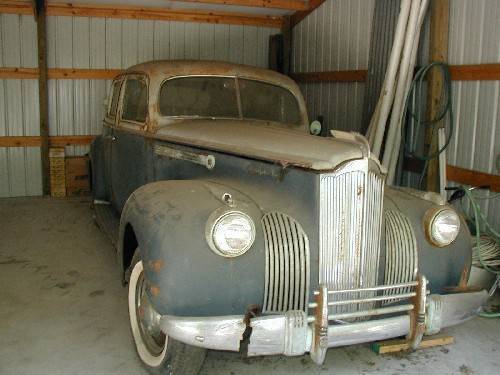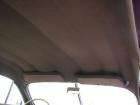|
'41 160 oil pan removal
|
||||
|---|---|---|---|---|
|
Not too shy to talk
|
Hi again everyone. Well, I have been trying to get to engine to turn, but so far no luck.
packardinfo.com/xoops/html/modules/newbb ... flat&order=ASC&type=&mode=0&start=0 " rel="noopener external" title="">Previous discussion on 1941 160 info I wondered if anyone have been able to slip the oil pan out with the engine jacked up but still not out. I want to get at the connecting rod bearing so I can clean and lube them up. I think that may set it free? I am not sure I am ready to pull the motor out completely yet. thanks Ken Johnston
Posted on: 2013/2/5 16:15
|
|||
|
||||
|
Re: '41 160 oil pan removal
|
||||
|---|---|---|---|---|
|
Home away from home

|
Dear Casey:
Usually the front motor mount sags down and inhibits clearance. So, remove the two bolts that go through the frame for the front motor mount, jack up the motor using a piece of wood under the oil pan and put two pieces of hardwood under the support arms. You will need to remove the clutch cover and turn the motor so that the pan will clear the crankshaft. Use penetrating oil on the mount bolts and let soak for a few days. Hope this helps
Posted on: 2013/2/5 16:41
|
|||
|
||||
|
Re: '41 160 oil pan removal
|
||||
|---|---|---|---|---|
|
Forum Ambassador
|
Ken,
That's an amazing break in the front bumper of your '41! 
Posted on: 2013/2/5 16:47
|
|||
|
Mal
/o[]o\ ====  Bowral, Southern Highlands of NSW, Australia "Out of chaos comes order" - Nietzsche. 1938 Eight Touring Sedan - SOLD 1941 One-Twenty Club Coupe - SOLD 1948 Super Eight Limo, chassis RHD - SOLD 1950 Eight Touring Sedan - SOLD What's this?  Put your Packard in the Packard Vehicle Registry! Here's how! Any questions - PM or email me at ozstatman@gmail.com |
||||
|
||||
|
Re: '41 160 oil pan removal
|
||||
|---|---|---|---|---|
|
Not too shy to talk
|
Thanks for all the info! I agree that the rings are suspect. I have been putting master blaster on them for a week. As far as rotating the crank to remove the pan, I wouln'd be doing this if I could move the crank.ha ha. So, I assume that if I cannot move the crank, I cannot get the pan off without having the engine on the floor. Correct?..Ken
Posted on: 2013/2/5 17:16
|
|||
|
||||
|
Re: '41 160 oil pan removal
|
||||
|---|---|---|---|---|
|
Not too shy to talk
|
One other thing. On the bumper break, I looked at it closely today and the lower section of the break is bent forward. It also has the look of a tension break on the edges. So my forensic analysis is that some caught the edge of the bumper when backing up. It stressed the bumper forward and ruptured it causing the break. I can find no other surrounding damage suggesting collision..Ken
Posted on: 2013/2/5 17:21
|
|||
|
||||
|
Re: '41 160 oil pan removal
|
||||
|---|---|---|---|---|
|
Home away from home
|
I'm curious - is that a 1903 or 1904?
Posted on: 2013/2/5 17:50
|
|||
|
||||
|
Re: '41 160 oil pan removal
|
||||
|---|---|---|---|---|
|
Just can't stay away
|
Casey Jay,
I made my living as a mechanic nearly four decades ago. Back then, if we had an engine seized up we'd drain the sump and leave the plug out and then pour as much Marvel Mystery Oil into each cylinder as the cylinders would hold, put a pan under the sump to catch the oil and then wait. And wait. And wait. Every morning we'd put a wrench on the front pully nut and give a gentle pull to see if things had freed up, if they hadn't, check to see how much MMO had made it to the sump and into our pan and then we'd top up each cyclinder and continue to wait. And wait, And wait..... Waiting was a pain but it cost an owner less than tearing into the motor. The MMO would usually do the trick and by and by free things up. If, after the engine began turning over, we could spin it with the starter with plugs out and coil wire grounded and it felt/sounded like things were moving freely, and we were getting proper compression on every cylinder, we'd top it up with some oil, put in the plugs, plug in the coil, cross our fingers and see if it would start. If it started, we'd have to wait about ten minutes for the white smoke to dissipate and the engine to get warmed up and then start listening for piston slap. Slap meant that the rings were seized to the pistons, in which case we knew we were going to have to tear it down. Sometimes the smoke didn't dissipate because anti-freeze was leaking into the cylinders and we'd find that we were dealing with a cracked block or a blown head gasket which also meant a tear down. You said in that other thread that you'd removed the engine and transmission and stored them separately from the vehicle for a number of years. Are you absolutely certain that all water was drained out the block when you put it in storage? It's one thing to have some rings seize to the cylinder walls because the cylinders are dry; it's quite another to have them seize because water left in the water jacket froze, expanded, cracked the block and got into the cylinders. Here's a tip - the next time you store a motor, use compressed air to blow out the cooling jacket, fill those cylinders with MMO and put some rubber plugs into the spark plug holes so you can occasionally replenish the MMO. Even if you are able to free the rings from the cylinder walls, there is about a 3-1 likelihood that the rings are not likely to have been freed up from the pistons. The cylinder walls are not the exact same diameter from top to bottom. As the piston moves downward the bottom ring expands and scrapes the cylinder wall free of most oil. As the piston travels upward again that ring and the others compress as the cylinder narrows near the top. That's why you'll need to check the compression on every cylinder before you try to crank it. If you have a cylinder with extremely low/no compression, don't even bother trying to run it our you'll screw it up. Even if you can turn it over, starting it could damage the motor if the rings have seized to those pistons. With the rings seized to the pistons where they've been compressed, those pistons will start to slap around in those cylinders as they come up because the rings can't expand and keep them centered. Rings that seize to the pistons in the expanded position can gouge their cylinder walls or break piston lands as the pistons move downward in the cylinders. Another thing you have to worry about is spalled cylinder walls. Sometimes when pistons seize to cylinder walls and are freed up the corrosion leaves microscopic spalling in the cylinder wall. If you break a motor down and the spalling isn't too bad, you can often use a hone to remove the spalling, throw in a new set of rings and put things backtgether and expect a decent result. If the cylinder walls have spalled and you don't clean them up, that rough spalled area may not scrape very clean and you'll end up with an engine that doesn't use a lot of oil but smokes a lot because of the trace oil left in the spalling. I just remembered. If you've got a hankering for a new toy for your mailbox, you might have another way to check things out. Harbor Freight sells a relatively inexpensive fiber-optic bore inspection camera. Quality-wise it's nowhere near the quality of the See Snake and other devices made by other tool makers that produce the same device for significantly more but it might be worth the investment. I know it's a pain in the keester, but if I were you I'd at least pull the head and see what I'm dealing with before I tried to start that engine after it has been seized so long. '41 Packard engine blocks don't grow on trees. I'd rather have to spend a few more hours getting dirty and sweaty than to stay cleaner and discover later that I'd damaged my engine beyond repair.
Posted on: 2013/2/5 20:01
|
|||
|
||||
|
Re: '41 160 oil pan removal
|
||||
|---|---|---|---|---|
|
Not too shy to talk
|
This Packard is a 1903. Thanks for the nice post Mike. Maybe, I just get a gal of MMO and sit and wait. The engine was stored dry. I think after this discussion, it is the rings frozen to the walls with corrosion. My goal, as I said in the first post, is to sell it. I know that I will get more interested parties if I can say the motor turns. I do not intend to start it. I wouldn't want to do that without a teardown. Just want to see the crank rotate...Ken
Posted on: 2013/2/5 20:50
|
|||
|
||||
|
Re: '41 160 oil pan removal
|
||||
|---|---|---|---|---|
|
Just can't stay away
|
Sorry,
Guess I got you mixed up with someone else's post about a 1941 Model 160. I'm not familiar with Packard Engines that old. Is that one of those engines with the cylinders and heads cast as a single unit and the rings and pistons are installed from the bottom vs. the top?
Posted on: 2013/2/5 21:25
|
|||
|
||||

 (99.40 KB)
(99.40 KB)








